Law and Ethics in Health Service Management
VerifiedAdded on 2023/06/07
|14
|3866
|395
AI Summary
This article discusses the importance of open disclosure in healthcare, the process involved, and recommendations for policy development. It covers topics such as information provided to consumers and clinical staff, medico-legal and ethical considerations, and the role of managers in the process.
Contribute Materials
Your contribution can guide someone’s learning journey. Share your
documents today.
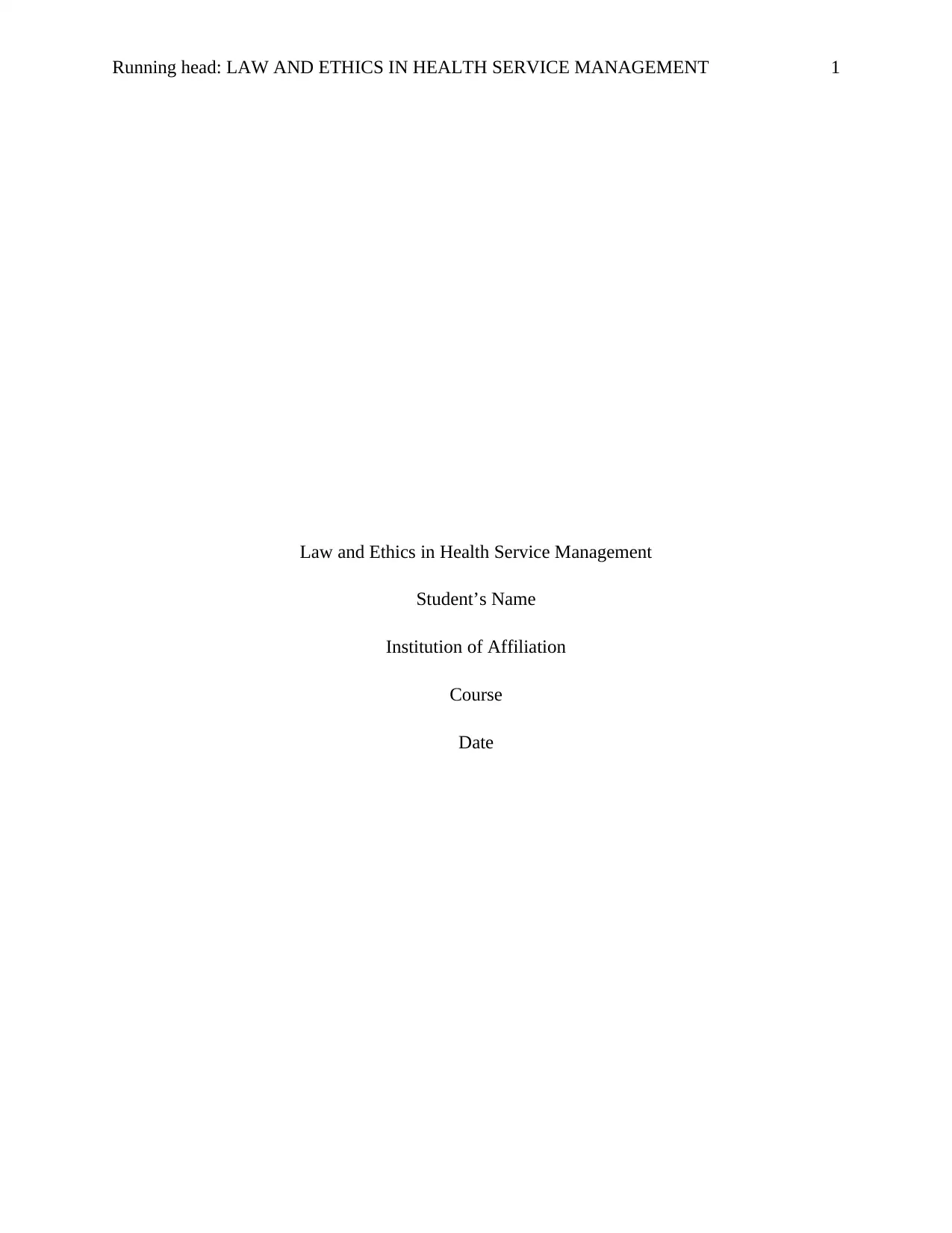
Running head: LAW AND ETHICS IN HEALTH SERVICE MANAGEMENT 1
Law and Ethics in Health Service Management
Student’s Name
Institution of Affiliation
Course
Date
Law and Ethics in Health Service Management
Student’s Name
Institution of Affiliation
Course
Date
Secure Best Marks with AI Grader
Need help grading? Try our AI Grader for instant feedback on your assignments.
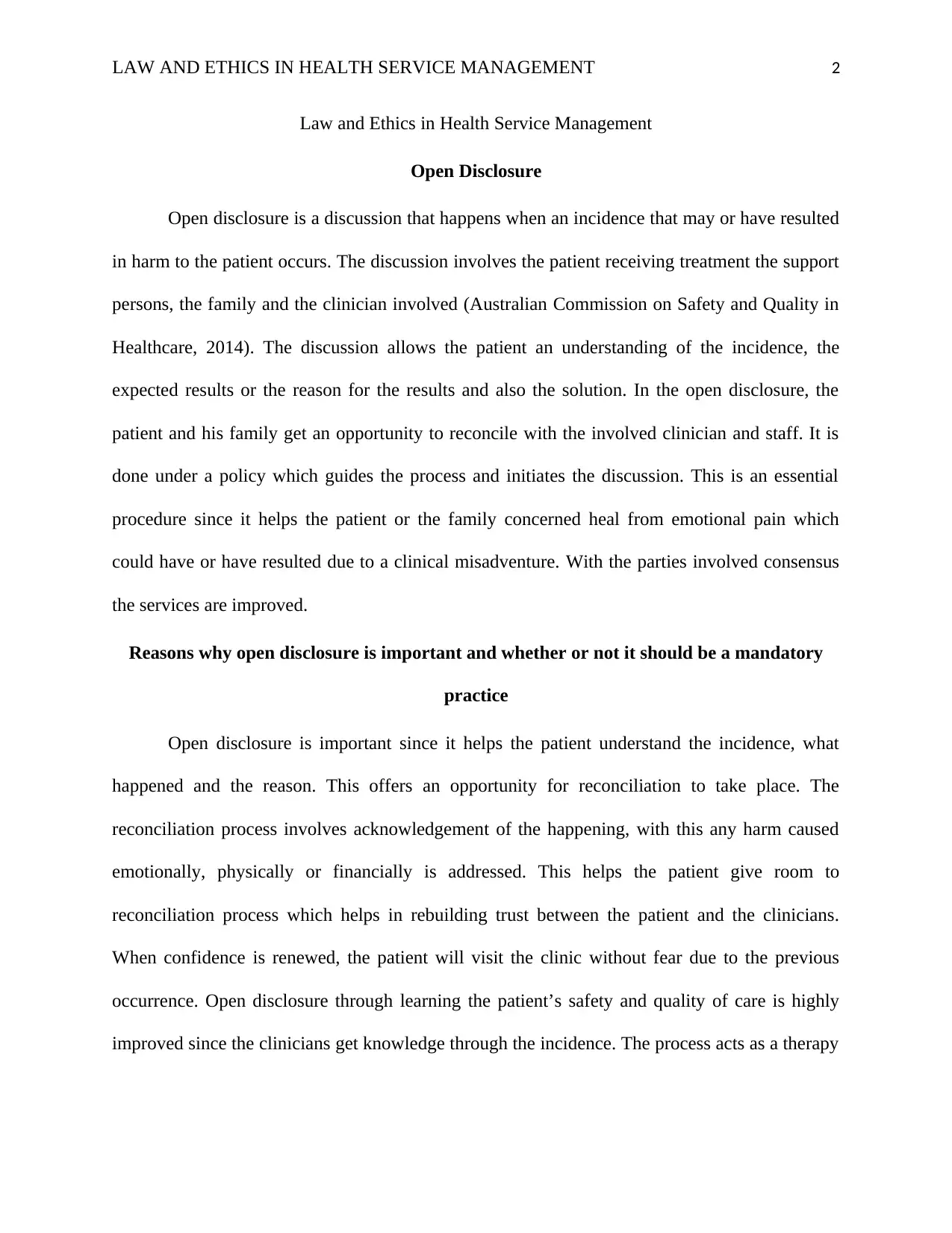
LAW AND ETHICS IN HEALTH SERVICE MANAGEMENT 2
Law and Ethics in Health Service Management
Open Disclosure
Open disclosure is a discussion that happens when an incidence that may or have resulted
in harm to the patient occurs. The discussion involves the patient receiving treatment the support
persons, the family and the clinician involved (Australian Commission on Safety and Quality in
Healthcare, 2014). The discussion allows the patient an understanding of the incidence, the
expected results or the reason for the results and also the solution. In the open disclosure, the
patient and his family get an opportunity to reconcile with the involved clinician and staff. It is
done under a policy which guides the process and initiates the discussion. This is an essential
procedure since it helps the patient or the family concerned heal from emotional pain which
could have or have resulted due to a clinical misadventure. With the parties involved consensus
the services are improved.
Reasons why open disclosure is important and whether or not it should be a mandatory
practice
Open disclosure is important since it helps the patient understand the incidence, what
happened and the reason. This offers an opportunity for reconciliation to take place. The
reconciliation process involves acknowledgement of the happening, with this any harm caused
emotionally, physically or financially is addressed. This helps the patient give room to
reconciliation process which helps in rebuilding trust between the patient and the clinicians.
When confidence is renewed, the patient will visit the clinic without fear due to the previous
occurrence. Open disclosure through learning the patient’s safety and quality of care is highly
improved since the clinicians get knowledge through the incidence. The process acts as a therapy
Law and Ethics in Health Service Management
Open Disclosure
Open disclosure is a discussion that happens when an incidence that may or have resulted
in harm to the patient occurs. The discussion involves the patient receiving treatment the support
persons, the family and the clinician involved (Australian Commission on Safety and Quality in
Healthcare, 2014). The discussion allows the patient an understanding of the incidence, the
expected results or the reason for the results and also the solution. In the open disclosure, the
patient and his family get an opportunity to reconcile with the involved clinician and staff. It is
done under a policy which guides the process and initiates the discussion. This is an essential
procedure since it helps the patient or the family concerned heal from emotional pain which
could have or have resulted due to a clinical misadventure. With the parties involved consensus
the services are improved.
Reasons why open disclosure is important and whether or not it should be a mandatory
practice
Open disclosure is important since it helps the patient understand the incidence, what
happened and the reason. This offers an opportunity for reconciliation to take place. The
reconciliation process involves acknowledgement of the happening, with this any harm caused
emotionally, physically or financially is addressed. This helps the patient give room to
reconciliation process which helps in rebuilding trust between the patient and the clinicians.
When confidence is renewed, the patient will visit the clinic without fear due to the previous
occurrence. Open disclosure through learning the patient’s safety and quality of care is highly
improved since the clinicians get knowledge through the incidence. The process acts as a therapy
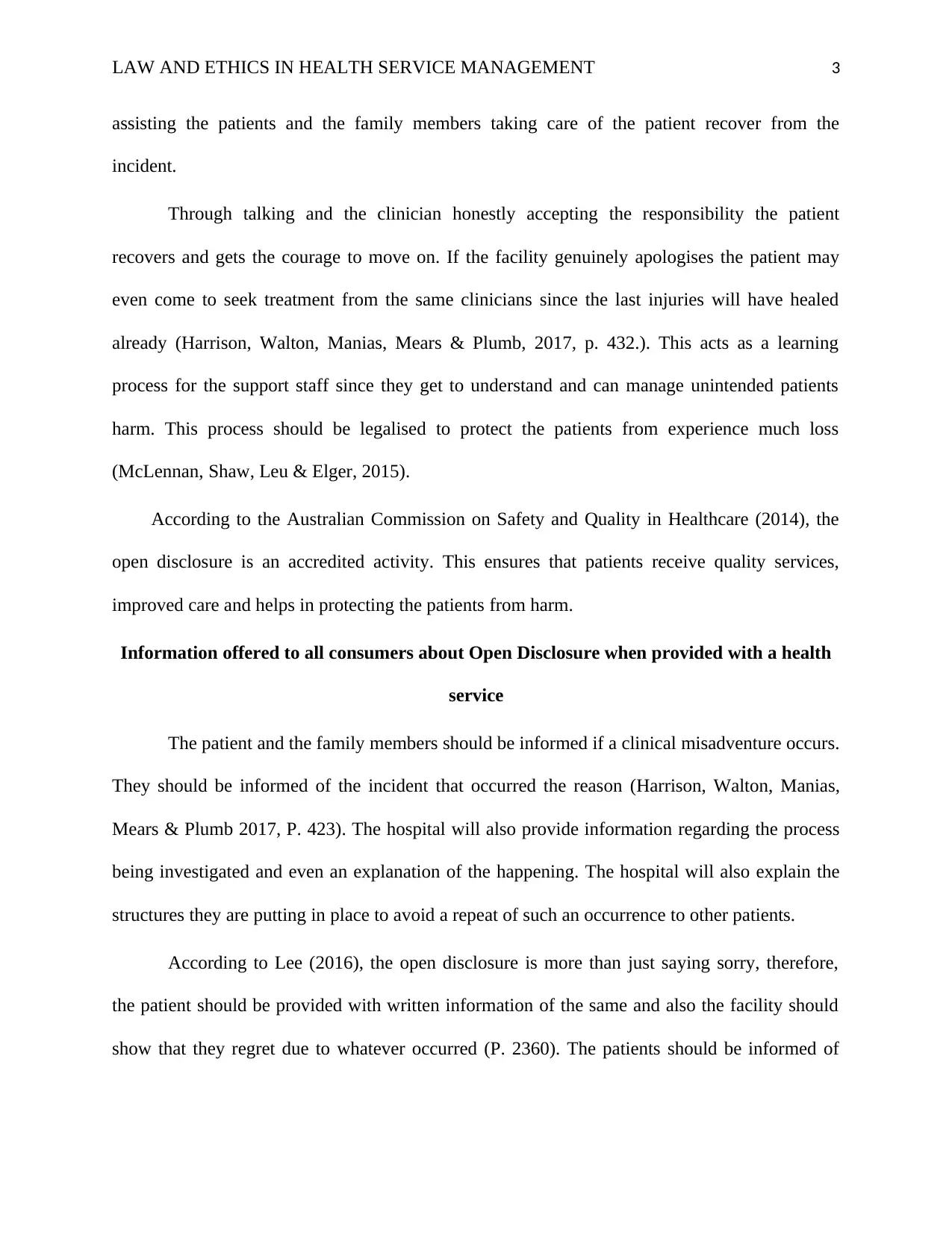
LAW AND ETHICS IN HEALTH SERVICE MANAGEMENT 3
assisting the patients and the family members taking care of the patient recover from the
incident.
Through talking and the clinician honestly accepting the responsibility the patient
recovers and gets the courage to move on. If the facility genuinely apologises the patient may
even come to seek treatment from the same clinicians since the last injuries will have healed
already (Harrison, Walton, Manias, Mears & Plumb, 2017, p. 432.). This acts as a learning
process for the support staff since they get to understand and can manage unintended patients
harm. This process should be legalised to protect the patients from experience much loss
(McLennan, Shaw, Leu & Elger, 2015).
According to the Australian Commission on Safety and Quality in Healthcare (2014), the
open disclosure is an accredited activity. This ensures that patients receive quality services,
improved care and helps in protecting the patients from harm.
Information offered to all consumers about Open Disclosure when provided with a health
service
The patient and the family members should be informed if a clinical misadventure occurs.
They should be informed of the incident that occurred the reason (Harrison, Walton, Manias,
Mears & Plumb 2017, P. 423). The hospital will also provide information regarding the process
being investigated and even an explanation of the happening. The hospital will also explain the
structures they are putting in place to avoid a repeat of such an occurrence to other patients.
According to Lee (2016), the open disclosure is more than just saying sorry, therefore,
the patient should be provided with written information of the same and also the facility should
show that they regret due to whatever occurred (P. 2360). The patients should be informed of
assisting the patients and the family members taking care of the patient recover from the
incident.
Through talking and the clinician honestly accepting the responsibility the patient
recovers and gets the courage to move on. If the facility genuinely apologises the patient may
even come to seek treatment from the same clinicians since the last injuries will have healed
already (Harrison, Walton, Manias, Mears & Plumb, 2017, p. 432.). This acts as a learning
process for the support staff since they get to understand and can manage unintended patients
harm. This process should be legalised to protect the patients from experience much loss
(McLennan, Shaw, Leu & Elger, 2015).
According to the Australian Commission on Safety and Quality in Healthcare (2014), the
open disclosure is an accredited activity. This ensures that patients receive quality services,
improved care and helps in protecting the patients from harm.
Information offered to all consumers about Open Disclosure when provided with a health
service
The patient and the family members should be informed if a clinical misadventure occurs.
They should be informed of the incident that occurred the reason (Harrison, Walton, Manias,
Mears & Plumb 2017, P. 423). The hospital will also provide information regarding the process
being investigated and even an explanation of the happening. The hospital will also explain the
structures they are putting in place to avoid a repeat of such an occurrence to other patients.
According to Lee (2016), the open disclosure is more than just saying sorry, therefore,
the patient should be provided with written information of the same and also the facility should
show that they regret due to whatever occurred (P. 2360). The patients should be informed of
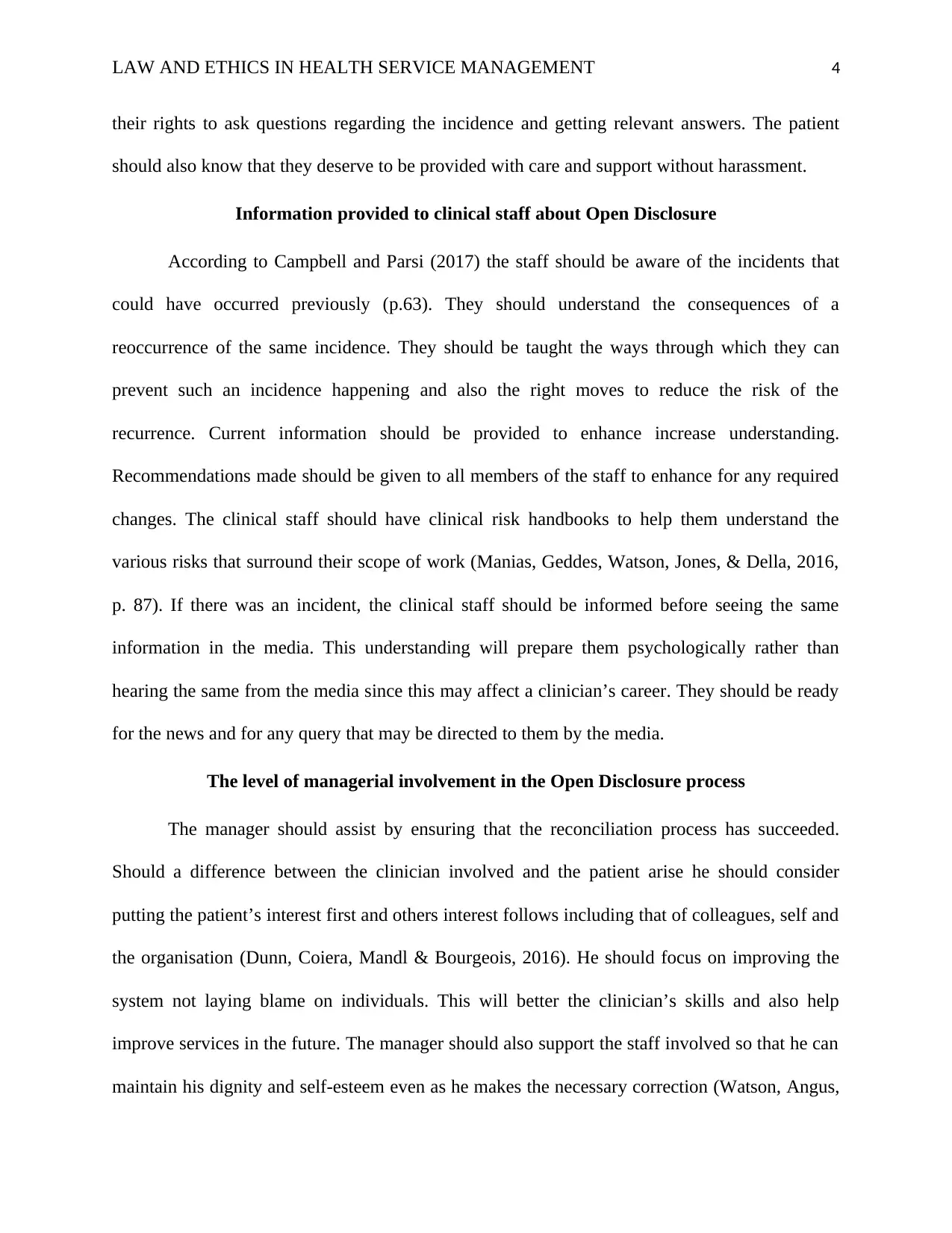
LAW AND ETHICS IN HEALTH SERVICE MANAGEMENT 4
their rights to ask questions regarding the incidence and getting relevant answers. The patient
should also know that they deserve to be provided with care and support without harassment.
Information provided to clinical staff about Open Disclosure
According to Campbell and Parsi (2017) the staff should be aware of the incidents that
could have occurred previously (p.63). They should understand the consequences of a
reoccurrence of the same incidence. They should be taught the ways through which they can
prevent such an incidence happening and also the right moves to reduce the risk of the
recurrence. Current information should be provided to enhance increase understanding.
Recommendations made should be given to all members of the staff to enhance for any required
changes. The clinical staff should have clinical risk handbooks to help them understand the
various risks that surround their scope of work (Manias, Geddes, Watson, Jones, & Della, 2016,
p. 87). If there was an incident, the clinical staff should be informed before seeing the same
information in the media. This understanding will prepare them psychologically rather than
hearing the same from the media since this may affect a clinician’s career. They should be ready
for the news and for any query that may be directed to them by the media.
The level of managerial involvement in the Open Disclosure process
The manager should assist by ensuring that the reconciliation process has succeeded.
Should a difference between the clinician involved and the patient arise he should consider
putting the patient’s interest first and others interest follows including that of colleagues, self and
the organisation (Dunn, Coiera, Mandl & Bourgeois, 2016). He should focus on improving the
system not laying blame on individuals. This will better the clinician’s skills and also help
improve services in the future. The manager should also support the staff involved so that he can
maintain his dignity and self-esteem even as he makes the necessary correction (Watson, Angus,
their rights to ask questions regarding the incidence and getting relevant answers. The patient
should also know that they deserve to be provided with care and support without harassment.
Information provided to clinical staff about Open Disclosure
According to Campbell and Parsi (2017) the staff should be aware of the incidents that
could have occurred previously (p.63). They should understand the consequences of a
reoccurrence of the same incidence. They should be taught the ways through which they can
prevent such an incidence happening and also the right moves to reduce the risk of the
recurrence. Current information should be provided to enhance increase understanding.
Recommendations made should be given to all members of the staff to enhance for any required
changes. The clinical staff should have clinical risk handbooks to help them understand the
various risks that surround their scope of work (Manias, Geddes, Watson, Jones, & Della, 2016,
p. 87). If there was an incident, the clinical staff should be informed before seeing the same
information in the media. This understanding will prepare them psychologically rather than
hearing the same from the media since this may affect a clinician’s career. They should be ready
for the news and for any query that may be directed to them by the media.
The level of managerial involvement in the Open Disclosure process
The manager should assist by ensuring that the reconciliation process has succeeded.
Should a difference between the clinician involved and the patient arise he should consider
putting the patient’s interest first and others interest follows including that of colleagues, self and
the organisation (Dunn, Coiera, Mandl & Bourgeois, 2016). He should focus on improving the
system not laying blame on individuals. This will better the clinician’s skills and also help
improve services in the future. The manager should also support the staff involved so that he can
maintain his dignity and self-esteem even as he makes the necessary correction (Watson, Angus,
Secure Best Marks with AI Grader
Need help grading? Try our AI Grader for instant feedback on your assignments.
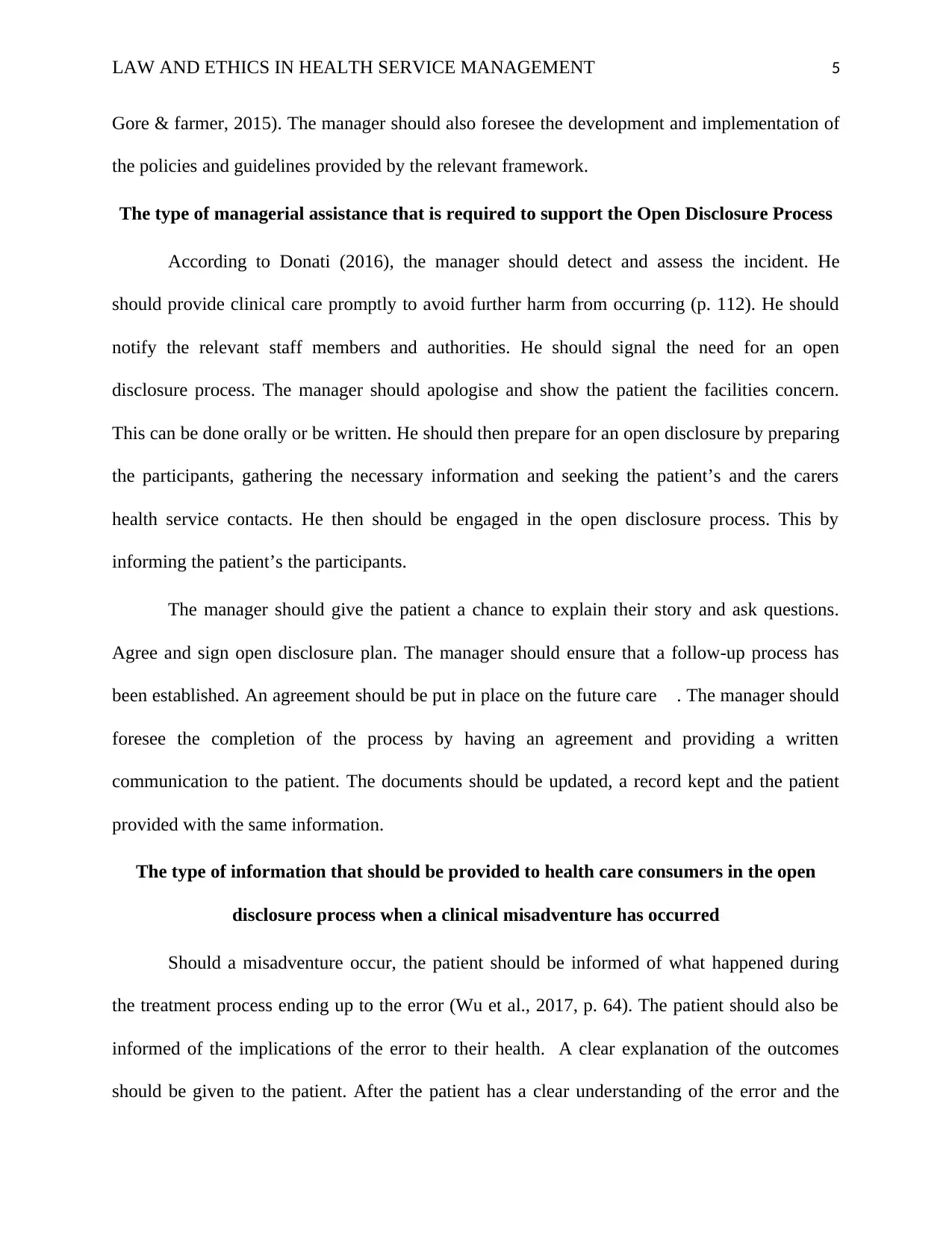
LAW AND ETHICS IN HEALTH SERVICE MANAGEMENT 5
Gore & farmer, 2015). The manager should also foresee the development and implementation of
the policies and guidelines provided by the relevant framework.
The type of managerial assistance that is required to support the Open Disclosure Process
According to Donati (2016), the manager should detect and assess the incident. He
should provide clinical care promptly to avoid further harm from occurring (p. 112). He should
notify the relevant staff members and authorities. He should signal the need for an open
disclosure process. The manager should apologise and show the patient the facilities concern.
This can be done orally or be written. He should then prepare for an open disclosure by preparing
the participants, gathering the necessary information and seeking the patient’s and the carers
health service contacts. He then should be engaged in the open disclosure process. This by
informing the patient’s the participants.
The manager should give the patient a chance to explain their story and ask questions.
Agree and sign open disclosure plan. The manager should ensure that a follow-up process has
been established. An agreement should be put in place on the future care . The manager should
foresee the completion of the process by having an agreement and providing a written
communication to the patient. The documents should be updated, a record kept and the patient
provided with the same information.
The type of information that should be provided to health care consumers in the open
disclosure process when a clinical misadventure has occurred
Should a misadventure occur, the patient should be informed of what happened during
the treatment process ending up to the error (Wu et al., 2017, p. 64). The patient should also be
informed of the implications of the error to their health. A clear explanation of the outcomes
should be given to the patient. After the patient has a clear understanding of the error and the
Gore & farmer, 2015). The manager should also foresee the development and implementation of
the policies and guidelines provided by the relevant framework.
The type of managerial assistance that is required to support the Open Disclosure Process
According to Donati (2016), the manager should detect and assess the incident. He
should provide clinical care promptly to avoid further harm from occurring (p. 112). He should
notify the relevant staff members and authorities. He should signal the need for an open
disclosure process. The manager should apologise and show the patient the facilities concern.
This can be done orally or be written. He should then prepare for an open disclosure by preparing
the participants, gathering the necessary information and seeking the patient’s and the carers
health service contacts. He then should be engaged in the open disclosure process. This by
informing the patient’s the participants.
The manager should give the patient a chance to explain their story and ask questions.
Agree and sign open disclosure plan. The manager should ensure that a follow-up process has
been established. An agreement should be put in place on the future care . The manager should
foresee the completion of the process by having an agreement and providing a written
communication to the patient. The documents should be updated, a record kept and the patient
provided with the same information.
The type of information that should be provided to health care consumers in the open
disclosure process when a clinical misadventure has occurred
Should a misadventure occur, the patient should be informed of what happened during
the treatment process ending up to the error (Wu et al., 2017, p. 64). The patient should also be
informed of the implications of the error to their health. A clear explanation of the outcomes
should be given to the patient. After the patient has a clear understanding of the error and the
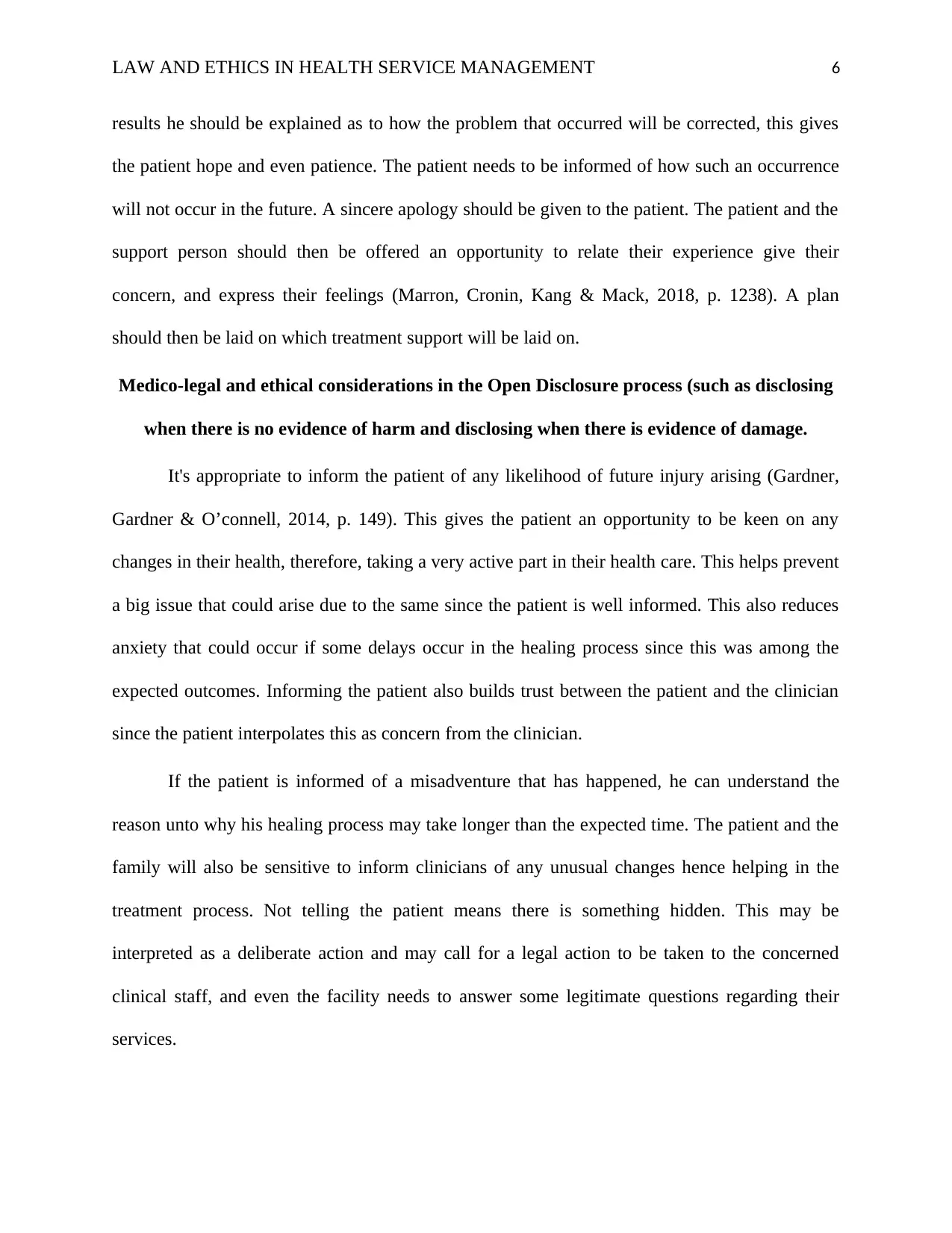
LAW AND ETHICS IN HEALTH SERVICE MANAGEMENT 6
results he should be explained as to how the problem that occurred will be corrected, this gives
the patient hope and even patience. The patient needs to be informed of how such an occurrence
will not occur in the future. A sincere apology should be given to the patient. The patient and the
support person should then be offered an opportunity to relate their experience give their
concern, and express their feelings (Marron, Cronin, Kang & Mack, 2018, p. 1238). A plan
should then be laid on which treatment support will be laid on.
Medico-legal and ethical considerations in the Open Disclosure process (such as disclosing
when there is no evidence of harm and disclosing when there is evidence of damage.
It's appropriate to inform the patient of any likelihood of future injury arising (Gardner,
Gardner & O’connell, 2014, p. 149). This gives the patient an opportunity to be keen on any
changes in their health, therefore, taking a very active part in their health care. This helps prevent
a big issue that could arise due to the same since the patient is well informed. This also reduces
anxiety that could occur if some delays occur in the healing process since this was among the
expected outcomes. Informing the patient also builds trust between the patient and the clinician
since the patient interpolates this as concern from the clinician.
If the patient is informed of a misadventure that has happened, he can understand the
reason unto why his healing process may take longer than the expected time. The patient and the
family will also be sensitive to inform clinicians of any unusual changes hence helping in the
treatment process. Not telling the patient means there is something hidden. This may be
interpreted as a deliberate action and may call for a legal action to be taken to the concerned
clinical staff, and even the facility needs to answer some legitimate questions regarding their
services.
results he should be explained as to how the problem that occurred will be corrected, this gives
the patient hope and even patience. The patient needs to be informed of how such an occurrence
will not occur in the future. A sincere apology should be given to the patient. The patient and the
support person should then be offered an opportunity to relate their experience give their
concern, and express their feelings (Marron, Cronin, Kang & Mack, 2018, p. 1238). A plan
should then be laid on which treatment support will be laid on.
Medico-legal and ethical considerations in the Open Disclosure process (such as disclosing
when there is no evidence of harm and disclosing when there is evidence of damage.
It's appropriate to inform the patient of any likelihood of future injury arising (Gardner,
Gardner & O’connell, 2014, p. 149). This gives the patient an opportunity to be keen on any
changes in their health, therefore, taking a very active part in their health care. This helps prevent
a big issue that could arise due to the same since the patient is well informed. This also reduces
anxiety that could occur if some delays occur in the healing process since this was among the
expected outcomes. Informing the patient also builds trust between the patient and the clinician
since the patient interpolates this as concern from the clinician.
If the patient is informed of a misadventure that has happened, he can understand the
reason unto why his healing process may take longer than the expected time. The patient and the
family will also be sensitive to inform clinicians of any unusual changes hence helping in the
treatment process. Not telling the patient means there is something hidden. This may be
interpreted as a deliberate action and may call for a legal action to be taken to the concerned
clinical staff, and even the facility needs to answer some legitimate questions regarding their
services.
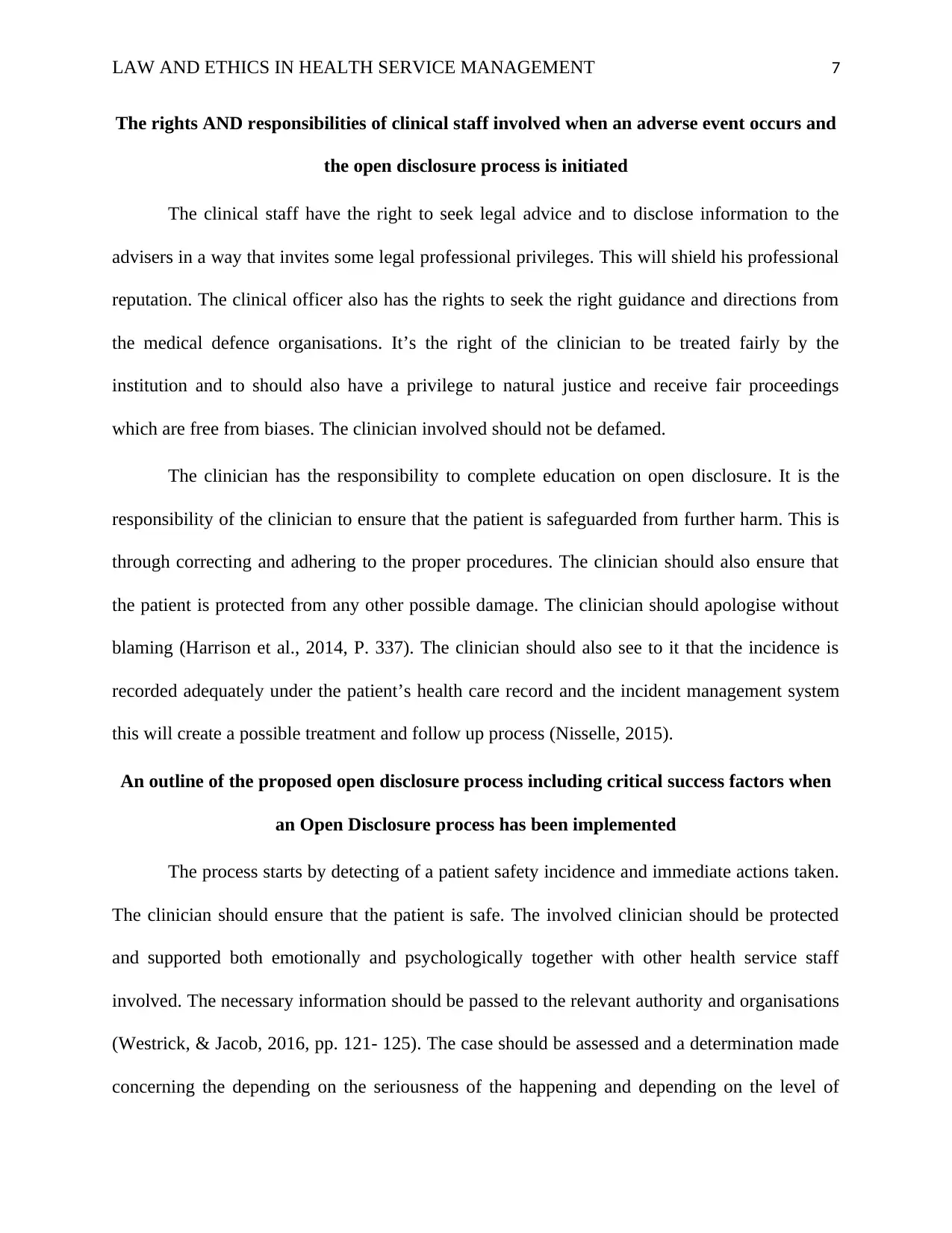
LAW AND ETHICS IN HEALTH SERVICE MANAGEMENT 7
The rights AND responsibilities of clinical staff involved when an adverse event occurs and
the open disclosure process is initiated
The clinical staff have the right to seek legal advice and to disclose information to the
advisers in a way that invites some legal professional privileges. This will shield his professional
reputation. The clinical officer also has the rights to seek the right guidance and directions from
the medical defence organisations. It’s the right of the clinician to be treated fairly by the
institution and to should also have a privilege to natural justice and receive fair proceedings
which are free from biases. The clinician involved should not be defamed.
The clinician has the responsibility to complete education on open disclosure. It is the
responsibility of the clinician to ensure that the patient is safeguarded from further harm. This is
through correcting and adhering to the proper procedures. The clinician should also ensure that
the patient is protected from any other possible damage. The clinician should apologise without
blaming (Harrison et al., 2014, P. 337). The clinician should also see to it that the incidence is
recorded adequately under the patient’s health care record and the incident management system
this will create a possible treatment and follow up process (Nisselle, 2015).
An outline of the proposed open disclosure process including critical success factors when
an Open Disclosure process has been implemented
The process starts by detecting of a patient safety incidence and immediate actions taken.
The clinician should ensure that the patient is safe. The involved clinician should be protected
and supported both emotionally and psychologically together with other health service staff
involved. The necessary information should be passed to the relevant authority and organisations
(Westrick, & Jacob, 2016, pp. 121- 125). The case should be assessed and a determination made
concerning the depending on the seriousness of the happening and depending on the level of
The rights AND responsibilities of clinical staff involved when an adverse event occurs and
the open disclosure process is initiated
The clinical staff have the right to seek legal advice and to disclose information to the
advisers in a way that invites some legal professional privileges. This will shield his professional
reputation. The clinical officer also has the rights to seek the right guidance and directions from
the medical defence organisations. It’s the right of the clinician to be treated fairly by the
institution and to should also have a privilege to natural justice and receive fair proceedings
which are free from biases. The clinician involved should not be defamed.
The clinician has the responsibility to complete education on open disclosure. It is the
responsibility of the clinician to ensure that the patient is safeguarded from further harm. This is
through correcting and adhering to the proper procedures. The clinician should also ensure that
the patient is protected from any other possible damage. The clinician should apologise without
blaming (Harrison et al., 2014, P. 337). The clinician should also see to it that the incidence is
recorded adequately under the patient’s health care record and the incident management system
this will create a possible treatment and follow up process (Nisselle, 2015).
An outline of the proposed open disclosure process including critical success factors when
an Open Disclosure process has been implemented
The process starts by detecting of a patient safety incidence and immediate actions taken.
The clinician should ensure that the patient is safe. The involved clinician should be protected
and supported both emotionally and psychologically together with other health service staff
involved. The necessary information should be passed to the relevant authority and organisations
(Westrick, & Jacob, 2016, pp. 121- 125). The case should be assessed and a determination made
concerning the depending on the seriousness of the happening and depending on the level of
Paraphrase This Document
Need a fresh take? Get an instant paraphrase of this document with our AI Paraphraser
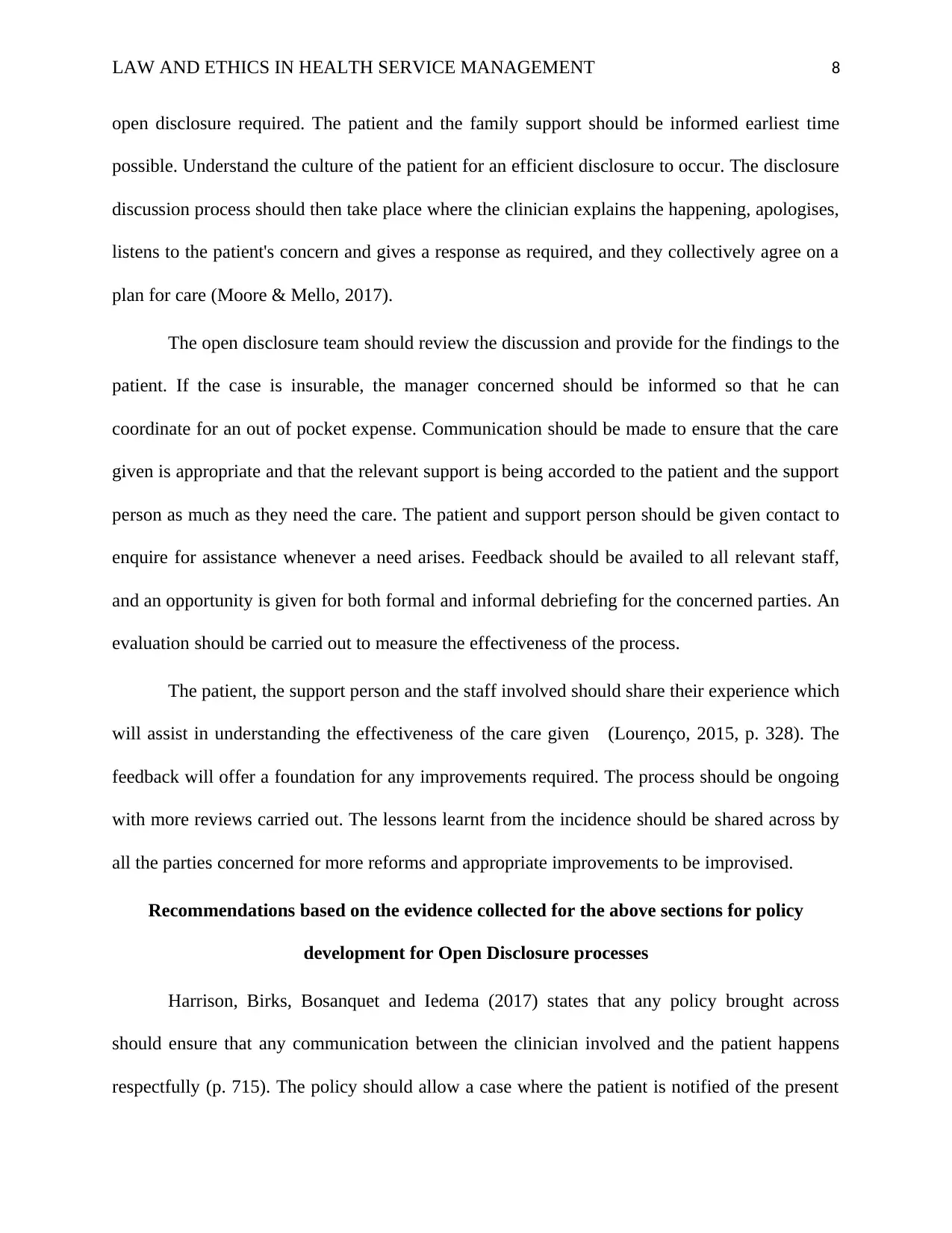
LAW AND ETHICS IN HEALTH SERVICE MANAGEMENT 8
open disclosure required. The patient and the family support should be informed earliest time
possible. Understand the culture of the patient for an efficient disclosure to occur. The disclosure
discussion process should then take place where the clinician explains the happening, apologises,
listens to the patient's concern and gives a response as required, and they collectively agree on a
plan for care (Moore & Mello, 2017).
The open disclosure team should review the discussion and provide for the findings to the
patient. If the case is insurable, the manager concerned should be informed so that he can
coordinate for an out of pocket expense. Communication should be made to ensure that the care
given is appropriate and that the relevant support is being accorded to the patient and the support
person as much as they need the care. The patient and support person should be given contact to
enquire for assistance whenever a need arises. Feedback should be availed to all relevant staff,
and an opportunity is given for both formal and informal debriefing for the concerned parties. An
evaluation should be carried out to measure the effectiveness of the process.
The patient, the support person and the staff involved should share their experience which
will assist in understanding the effectiveness of the care given (Lourenço, 2015, p. 328). The
feedback will offer a foundation for any improvements required. The process should be ongoing
with more reviews carried out. The lessons learnt from the incidence should be shared across by
all the parties concerned for more reforms and appropriate improvements to be improvised.
Recommendations based on the evidence collected for the above sections for policy
development for Open Disclosure processes
Harrison, Birks, Bosanquet and Iedema (2017) states that any policy brought across
should ensure that any communication between the clinician involved and the patient happens
respectfully (p. 715). The policy should allow a case where the patient is notified of the present
open disclosure required. The patient and the family support should be informed earliest time
possible. Understand the culture of the patient for an efficient disclosure to occur. The disclosure
discussion process should then take place where the clinician explains the happening, apologises,
listens to the patient's concern and gives a response as required, and they collectively agree on a
plan for care (Moore & Mello, 2017).
The open disclosure team should review the discussion and provide for the findings to the
patient. If the case is insurable, the manager concerned should be informed so that he can
coordinate for an out of pocket expense. Communication should be made to ensure that the care
given is appropriate and that the relevant support is being accorded to the patient and the support
person as much as they need the care. The patient and support person should be given contact to
enquire for assistance whenever a need arises. Feedback should be availed to all relevant staff,
and an opportunity is given for both formal and informal debriefing for the concerned parties. An
evaluation should be carried out to measure the effectiveness of the process.
The patient, the support person and the staff involved should share their experience which
will assist in understanding the effectiveness of the care given (Lourenço, 2015, p. 328). The
feedback will offer a foundation for any improvements required. The process should be ongoing
with more reviews carried out. The lessons learnt from the incidence should be shared across by
all the parties concerned for more reforms and appropriate improvements to be improvised.
Recommendations based on the evidence collected for the above sections for policy
development for Open Disclosure processes
Harrison, Birks, Bosanquet and Iedema (2017) states that any policy brought across
should ensure that any communication between the clinician involved and the patient happens
respectfully (p. 715). The policy should allow a case where the patient is notified of the present
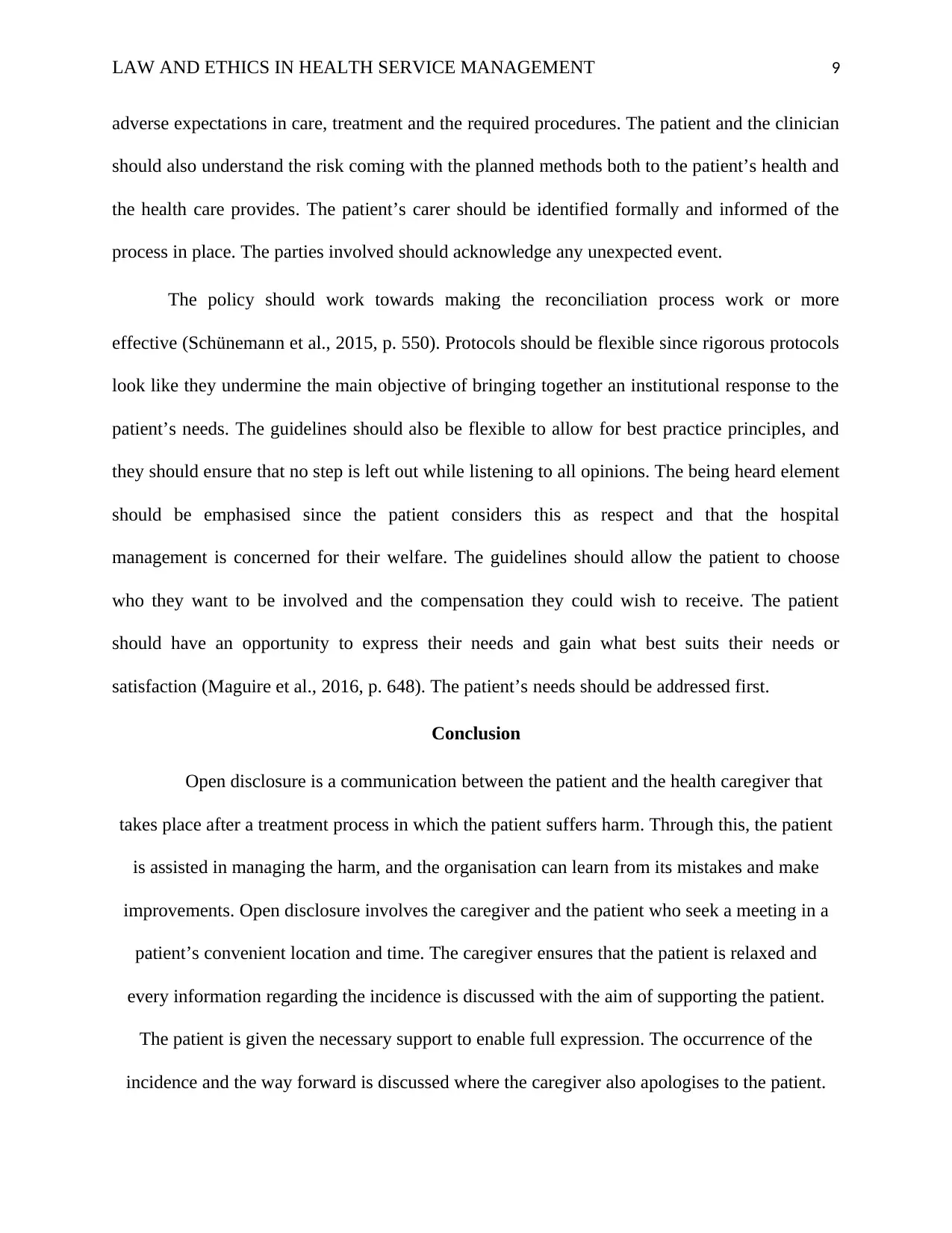
LAW AND ETHICS IN HEALTH SERVICE MANAGEMENT 9
adverse expectations in care, treatment and the required procedures. The patient and the clinician
should also understand the risk coming with the planned methods both to the patient’s health and
the health care provides. The patient’s carer should be identified formally and informed of the
process in place. The parties involved should acknowledge any unexpected event.
The policy should work towards making the reconciliation process work or more
effective (Schünemann et al., 2015, p. 550). Protocols should be flexible since rigorous protocols
look like they undermine the main objective of bringing together an institutional response to the
patient’s needs. The guidelines should also be flexible to allow for best practice principles, and
they should ensure that no step is left out while listening to all opinions. The being heard element
should be emphasised since the patient considers this as respect and that the hospital
management is concerned for their welfare. The guidelines should allow the patient to choose
who they want to be involved and the compensation they could wish to receive. The patient
should have an opportunity to express their needs and gain what best suits their needs or
satisfaction (Maguire et al., 2016, p. 648). The patient’s needs should be addressed first.
Conclusion
Open disclosure is a communication between the patient and the health caregiver that
takes place after a treatment process in which the patient suffers harm. Through this, the patient
is assisted in managing the harm, and the organisation can learn from its mistakes and make
improvements. Open disclosure involves the caregiver and the patient who seek a meeting in a
patient’s convenient location and time. The caregiver ensures that the patient is relaxed and
every information regarding the incidence is discussed with the aim of supporting the patient.
The patient is given the necessary support to enable full expression. The occurrence of the
incidence and the way forward is discussed where the caregiver also apologises to the patient.
adverse expectations in care, treatment and the required procedures. The patient and the clinician
should also understand the risk coming with the planned methods both to the patient’s health and
the health care provides. The patient’s carer should be identified formally and informed of the
process in place. The parties involved should acknowledge any unexpected event.
The policy should work towards making the reconciliation process work or more
effective (Schünemann et al., 2015, p. 550). Protocols should be flexible since rigorous protocols
look like they undermine the main objective of bringing together an institutional response to the
patient’s needs. The guidelines should also be flexible to allow for best practice principles, and
they should ensure that no step is left out while listening to all opinions. The being heard element
should be emphasised since the patient considers this as respect and that the hospital
management is concerned for their welfare. The guidelines should allow the patient to choose
who they want to be involved and the compensation they could wish to receive. The patient
should have an opportunity to express their needs and gain what best suits their needs or
satisfaction (Maguire et al., 2016, p. 648). The patient’s needs should be addressed first.
Conclusion
Open disclosure is a communication between the patient and the health caregiver that
takes place after a treatment process in which the patient suffers harm. Through this, the patient
is assisted in managing the harm, and the organisation can learn from its mistakes and make
improvements. Open disclosure involves the caregiver and the patient who seek a meeting in a
patient’s convenient location and time. The caregiver ensures that the patient is relaxed and
every information regarding the incidence is discussed with the aim of supporting the patient.
The patient is given the necessary support to enable full expression. The occurrence of the
incidence and the way forward is discussed where the caregiver also apologises to the patient.

LAW AND ETHICS IN HEALTH SERVICE MANAGEMENT 10
The open disclosure enhances trust between the caregiver and the patient which improves the
patient’s safety as the patient becomes an active partner in their care.
The open disclosure enhances trust between the caregiver and the patient which improves the
patient’s safety as the patient becomes an active partner in their care.
Secure Best Marks with AI Grader
Need help grading? Try our AI Grader for instant feedback on your assignments.
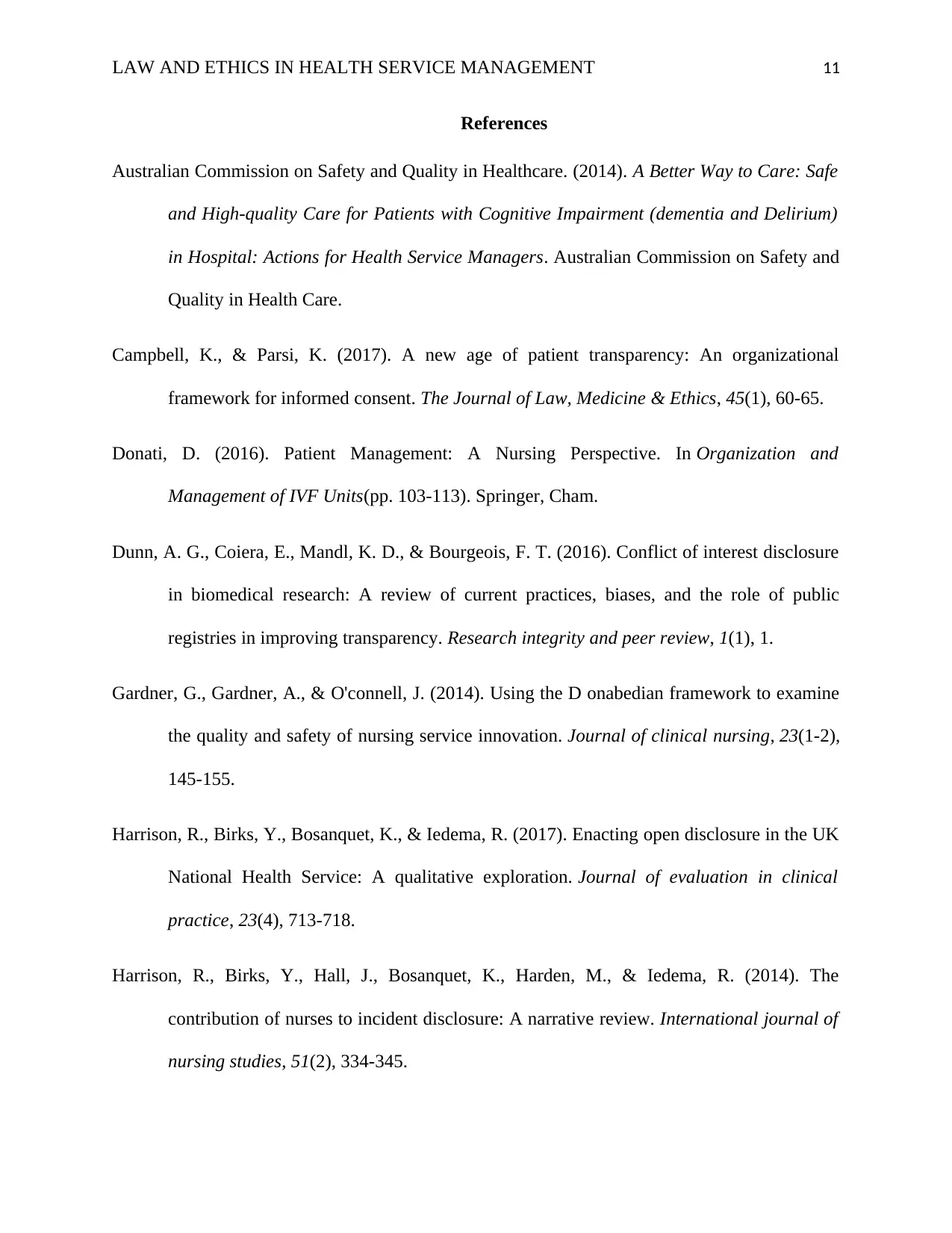
LAW AND ETHICS IN HEALTH SERVICE MANAGEMENT 11
References
Australian Commission on Safety and Quality in Healthcare. (2014). A Better Way to Care: Safe
and High-quality Care for Patients with Cognitive Impairment (dementia and Delirium)
in Hospital: Actions for Health Service Managers. Australian Commission on Safety and
Quality in Health Care.
Campbell, K., & Parsi, K. (2017). A new age of patient transparency: An organizational
framework for informed consent. The Journal of Law, Medicine & Ethics, 45(1), 60-65.
Donati, D. (2016). Patient Management: A Nursing Perspective. In Organization and
Management of IVF Units(pp. 103-113). Springer, Cham.
Dunn, A. G., Coiera, E., Mandl, K. D., & Bourgeois, F. T. (2016). Conflict of interest disclosure
in biomedical research: A review of current practices, biases, and the role of public
registries in improving transparency. Research integrity and peer review, 1(1), 1.
Gardner, G., Gardner, A., & O'connell, J. (2014). Using the D onabedian framework to examine
the quality and safety of nursing service innovation. Journal of clinical nursing, 23(1-2),
145-155.
Harrison, R., Birks, Y., Bosanquet, K., & Iedema, R. (2017). Enacting open disclosure in the UK
National Health Service: A qualitative exploration. Journal of evaluation in clinical
practice, 23(4), 713-718.
Harrison, R., Birks, Y., Hall, J., Bosanquet, K., Harden, M., & Iedema, R. (2014). The
contribution of nurses to incident disclosure: A narrative review. International journal of
nursing studies, 51(2), 334-345.
References
Australian Commission on Safety and Quality in Healthcare. (2014). A Better Way to Care: Safe
and High-quality Care for Patients with Cognitive Impairment (dementia and Delirium)
in Hospital: Actions for Health Service Managers. Australian Commission on Safety and
Quality in Health Care.
Campbell, K., & Parsi, K. (2017). A new age of patient transparency: An organizational
framework for informed consent. The Journal of Law, Medicine & Ethics, 45(1), 60-65.
Donati, D. (2016). Patient Management: A Nursing Perspective. In Organization and
Management of IVF Units(pp. 103-113). Springer, Cham.
Dunn, A. G., Coiera, E., Mandl, K. D., & Bourgeois, F. T. (2016). Conflict of interest disclosure
in biomedical research: A review of current practices, biases, and the role of public
registries in improving transparency. Research integrity and peer review, 1(1), 1.
Gardner, G., Gardner, A., & O'connell, J. (2014). Using the D onabedian framework to examine
the quality and safety of nursing service innovation. Journal of clinical nursing, 23(1-2),
145-155.
Harrison, R., Birks, Y., Bosanquet, K., & Iedema, R. (2017). Enacting open disclosure in the UK
National Health Service: A qualitative exploration. Journal of evaluation in clinical
practice, 23(4), 713-718.
Harrison, R., Birks, Y., Hall, J., Bosanquet, K., Harden, M., & Iedema, R. (2014). The
contribution of nurses to incident disclosure: A narrative review. International journal of
nursing studies, 51(2), 334-345.

LAW AND ETHICS IN HEALTH SERVICE MANAGEMENT 12
Harrison, R., Walton, M., Manias, E., Mears, S., & Plumb, J. (2017). Patients’ experiences in
Australian hospitals: A systematic review of evidence. Australian Health Review, 41(4),
419-435.
Lee, M. J. (2016). On patient safety: Do you say “I’m sorry” to patients?. Clinical Orthopaedics
and Related Research®, 474(11), 2359-2361.
Lourenço, R. P. (2015). An analysis of open government portals: A perspective of transparency
for accountability. Government Information Quarterly, 32(3), 323-332.
Maguire, E. M., Bokhour, B. G., Wagner, T. H., Asch, S. M., Gifford, A. L., Gallagher, T. H., ...
& Elwy, A. R. (2016). Evaluating the implementation of a national disclosure policy for
large-scale adverse events in an integrated health care system: Identification of gaps and
successes. BMC health services research, 16(1), 648.
Manias, E., Geddes, F., Watson, B., Jones, D., & Della, P. (2016). Perspectives of clinical
handover processes: A multi‐site survey across different health professionals. Journal of
clinical nursing, 25(1-2), 80-91.
Marron, J. M., Cronin, A. M., Kang, T. I., & Mack, J. W. (2018). Intended and unintended
consequences: Ethics, communication, and prognostic disclosure in pediatric
oncology. Cancer, 124(6), 1232-1241.
McLennan, S., Shaw, D., Leu, A., & Elger, B. (2015). Professional liability insurance and
medical error disclosure. Swiss Med Wkly, 145, w14164
Harrison, R., Walton, M., Manias, E., Mears, S., & Plumb, J. (2017). Patients’ experiences in
Australian hospitals: A systematic review of evidence. Australian Health Review, 41(4),
419-435.
Lee, M. J. (2016). On patient safety: Do you say “I’m sorry” to patients?. Clinical Orthopaedics
and Related Research®, 474(11), 2359-2361.
Lourenço, R. P. (2015). An analysis of open government portals: A perspective of transparency
for accountability. Government Information Quarterly, 32(3), 323-332.
Maguire, E. M., Bokhour, B. G., Wagner, T. H., Asch, S. M., Gifford, A. L., Gallagher, T. H., ...
& Elwy, A. R. (2016). Evaluating the implementation of a national disclosure policy for
large-scale adverse events in an integrated health care system: Identification of gaps and
successes. BMC health services research, 16(1), 648.
Manias, E., Geddes, F., Watson, B., Jones, D., & Della, P. (2016). Perspectives of clinical
handover processes: A multi‐site survey across different health professionals. Journal of
clinical nursing, 25(1-2), 80-91.
Marron, J. M., Cronin, A. M., Kang, T. I., & Mack, J. W. (2018). Intended and unintended
consequences: Ethics, communication, and prognostic disclosure in pediatric
oncology. Cancer, 124(6), 1232-1241.
McLennan, S., Shaw, D., Leu, A., & Elger, B. (2015). Professional liability insurance and
medical error disclosure. Swiss Med Wkly, 145, w14164
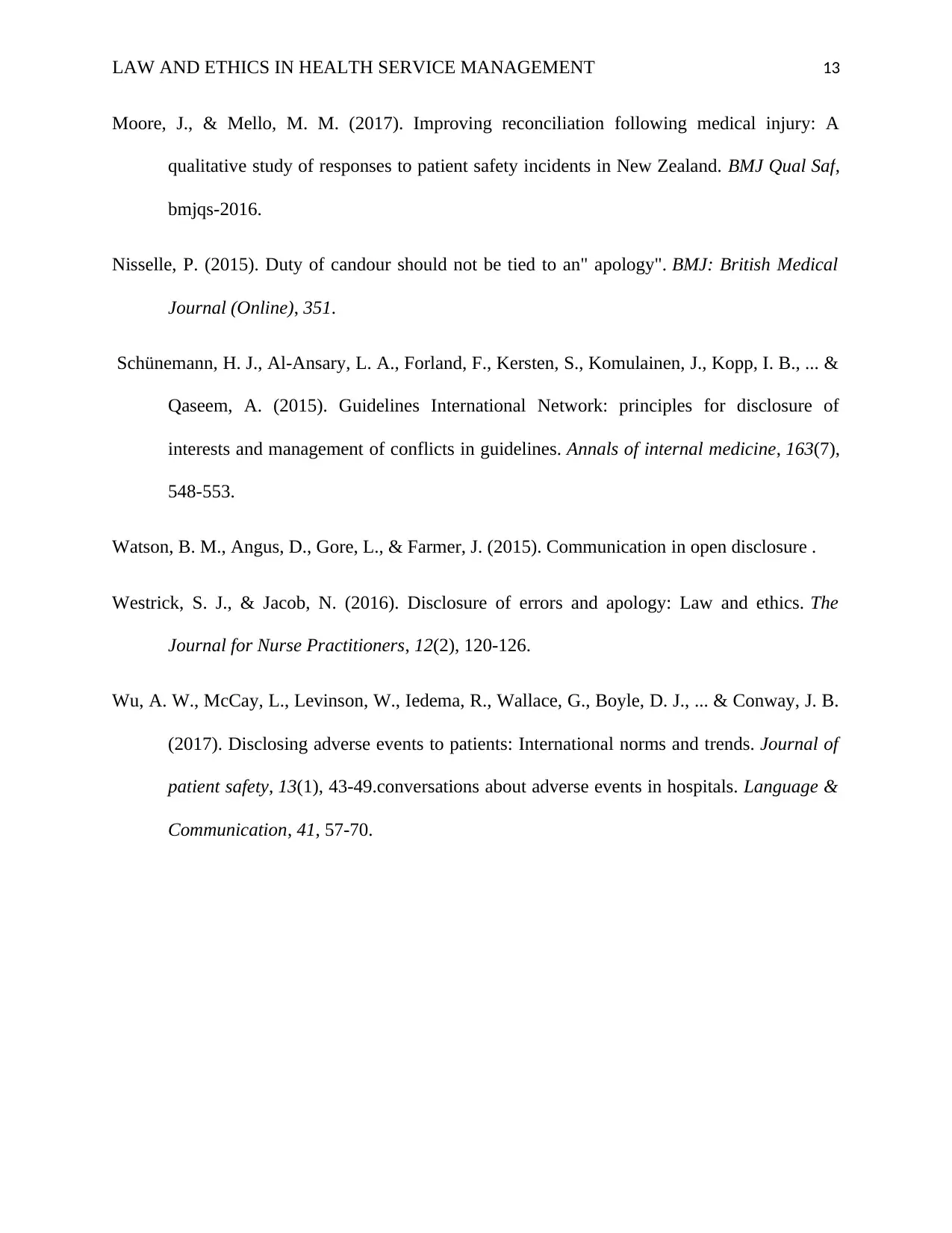
LAW AND ETHICS IN HEALTH SERVICE MANAGEMENT 13
Moore, J., & Mello, M. M. (2017). Improving reconciliation following medical injury: A
qualitative study of responses to patient safety incidents in New Zealand. BMJ Qual Saf,
bmjqs-2016.
Nisselle, P. (2015). Duty of candour should not be tied to an" apology". BMJ: British Medical
Journal (Online), 351.
Schünemann, H. J., Al-Ansary, L. A., Forland, F., Kersten, S., Komulainen, J., Kopp, I. B., ... &
Qaseem, A. (2015). Guidelines International Network: principles for disclosure of
interests and management of conflicts in guidelines. Annals of internal medicine, 163(7),
548-553.
Watson, B. M., Angus, D., Gore, L., & Farmer, J. (2015). Communication in open disclosure .
Westrick, S. J., & Jacob, N. (2016). Disclosure of errors and apology: Law and ethics. The
Journal for Nurse Practitioners, 12(2), 120-126.
Wu, A. W., McCay, L., Levinson, W., Iedema, R., Wallace, G., Boyle, D. J., ... & Conway, J. B.
(2017). Disclosing adverse events to patients: International norms and trends. Journal of
patient safety, 13(1), 43-49.conversations about adverse events in hospitals. Language &
Communication, 41, 57-70.
Moore, J., & Mello, M. M. (2017). Improving reconciliation following medical injury: A
qualitative study of responses to patient safety incidents in New Zealand. BMJ Qual Saf,
bmjqs-2016.
Nisselle, P. (2015). Duty of candour should not be tied to an" apology". BMJ: British Medical
Journal (Online), 351.
Schünemann, H. J., Al-Ansary, L. A., Forland, F., Kersten, S., Komulainen, J., Kopp, I. B., ... &
Qaseem, A. (2015). Guidelines International Network: principles for disclosure of
interests and management of conflicts in guidelines. Annals of internal medicine, 163(7),
548-553.
Watson, B. M., Angus, D., Gore, L., & Farmer, J. (2015). Communication in open disclosure .
Westrick, S. J., & Jacob, N. (2016). Disclosure of errors and apology: Law and ethics. The
Journal for Nurse Practitioners, 12(2), 120-126.
Wu, A. W., McCay, L., Levinson, W., Iedema, R., Wallace, G., Boyle, D. J., ... & Conway, J. B.
(2017). Disclosing adverse events to patients: International norms and trends. Journal of
patient safety, 13(1), 43-49.conversations about adverse events in hospitals. Language &
Communication, 41, 57-70.
Paraphrase This Document
Need a fresh take? Get an instant paraphrase of this document with our AI Paraphraser

LAW AND ETHICS IN HEALTH SERVICE MANAGEMENT 14
1 out of 14
Related Documents
Your All-in-One AI-Powered Toolkit for Academic Success.
+13062052269
info@desklib.com
Available 24*7 on WhatsApp / Email
![[object Object]](/_next/static/media/star-bottom.7253800d.svg)
Unlock your academic potential
© 2024 | Zucol Services PVT LTD | All rights reserved.





